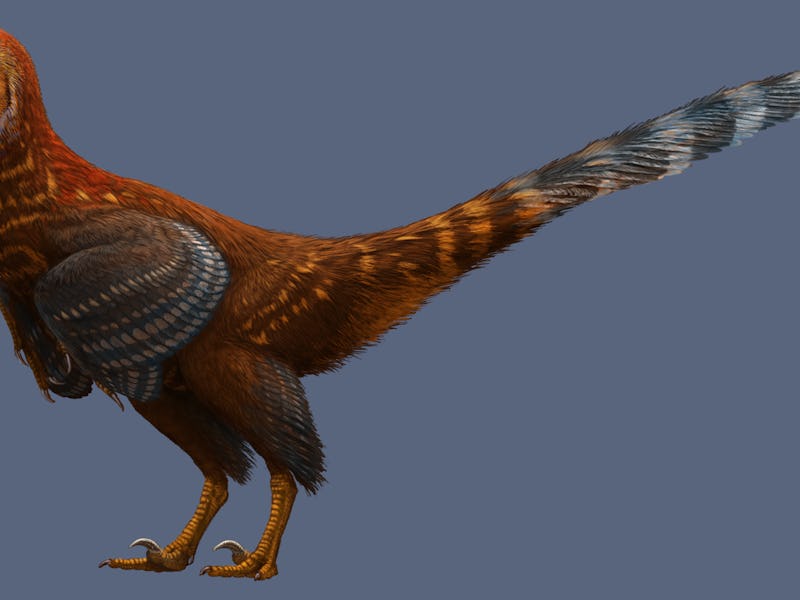New Feathered Dinosaur Helps Illuminate the Evolution of Flight
Paleontologists say this dinosaur is shaking up the evolutionary tree.

An international team of paleontologists recently discovered a new species of feathered dinosaur in China, and its physical characteristics are changing what we know about the evolution of flight. Paleontologists report that Jianianhualong tengi, which belongs to the family of bird-like dinosaurs known as a troodontids, lived about 125 million years ago.
This meter-long, bird-like dinosaur has features that could rewrite history. Its most striking characteristic, the researchers wrote in Nature Communications on Tuesday, are its asymmetrical feathers— which are often associated with birds that can fly. This simple anatomical feature, which was identified from fossilized imprints, suggests that the common ancestor of birds and troodontids is even older than was previously thought. If these findings are accurate, Jianianhualong would be the oldest troodontid to have asymmetrical feathers.
The paleontologists who investigated this new fossil, found in the Lower Cretaceous Jehol Group in China, a location known for its well-preserved specimens, explain in the paper that Jianianhualong appears to be a missing link between long-armed and short-armed troodontids.
Just as importantly, Jianianhualong could change the timeline for the evolution of feathers.
Jianianhualong tengi lived around 125 million years ago. It was about a meter long, only weighed a few pounds, and possessed feathers that are often associated with flight.
Other dinosaurs that lived in the Cretaceous period had symmetrical feathers. In this respect, Jianianhualong’s asymmetrical set was an anomaly — which is what makes them so special when it comes to establishing a timeline for the evolution of flight.
“Bird feathers need to be asymmetrical in order to form an airfoil,” Steve Brusatte, Ph.D., a vertebrate paleontologist at the University of Edinburgh who was not involved with the study, told Live Science. “It has to do with the physics of wing shape, the same way that airplane wings have to be designed a certain way.”
The exceptionally well-preserved fossil of Jianianhualong allowed paleontologists to find evidence of the small dinosaur's asymmetrical feathers.
A feather comprises a stiff quill in its center, together with the barbs — the soft hairs — that jut out of the quill. Asymmetrical feathers, like Jianianhualong’s, have barbs that are shorter on one side of the quill than on the other. While the researchers say Jianianhualong was probably flightless, the asymmetrical nature of its feathers suggests it’s a significant link in the evolutionary chain that eventually led to modern birds.
“It is widely accepted that feather asymmetry is important for [the] origin of bird flight,” Xu Xing, a paleontologist at the Chinese Academy of Sciences and lead author of the new study, told National Geographic. “And now we can demonstrate that this feature has a wide distribution outside the bird family.”
These images of Jianianhualong tengi's tail clearly show its frond-like tail.
In addition to its unique feathers, Jianianhualong also had what researchers refer to as a “mosaic” of features from earlier and later species of troodontids.
“Comparison of morphological features of Jianianhualong with those of other troodontids indicates that Jianianhualong has forelimbs and a pelvis closely resembling those of basal troodontids, but a cranium and hindlimbs that are more similar to those of derived troodontids,” write the researchers. In other words, this specimen seems to represent an evolutionary link between these two known types of dinosaurs.
And whenever a new species finds its place in the taxonomical and evolutionary structure, it brings up even more questions for the future.
“Every time you find a missing link between two animals, you create two new missing links,” Philip Currie, Ph.D., a paleobiologist at the University of Alberta and one of the study’s authors, told The Hamilton Spectator. “We’re looking for the answer as to why there’s a combination of primitive and advanced features.”
So even though the scientists can’t be sure whether this newly discovered troodontid could fly or not, one thing is for sure: Jianianhualong is shaking up its family tree.
Abstract: Asymmetrical feathers have been associated with flight capability but are also found in species that do not fly, and their appearance was a major event in feather evolution. Among non-avialan theropods, they are only known in microraptorine dromaeosaurids. Here we report a new troodontid, Jianianhualong tengi gen. et sp. nov., from the Lower Cretaceous Jehol Group of China, that has anatomical features that are transitional between long-armed basal troodontids and derived short-armed ones, shedding new light on troodontid character evolution. It indicates that troodontid feathering is similar to Archaeopteryx in having large arm and leg feathers as well as frond-like tail feathering, confirming that these feathering characteristics were widely present among basal paravians. Most significantly, the taxon has the earliest known asymmetrical troodontid feathers, suggesting that feather asymmetry was ancestral to Paraves. This taxon also displays a mosaic distribution of characters like Sinusonasus, another troodontid with transitional anatomical features.